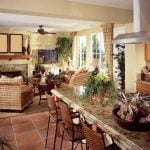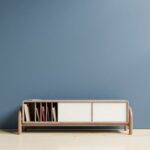Are you a fan of retro aesthetics and vintage design? If so, you might be interested in exploring what constitutes 80’s home decor. The 1980s was a decade marked by bold colors, geometric patterns, and futuristic influences that still hold nostalgic charm for many today. From statement furniture pieces to the rise of neon lighting and the integration of high-tech gadgets, 80’s home decor trends continue to have a lasting impact on contemporary interior design.
The signature look of 80’s interior design often revolved around bold colors and geometric patterns, giving living spaces a vibrant and energetic feel. From neon pinks and electric blues to checkerboard prints and angular shapes, 80’s home decor was anything but understated. This era also saw the rise of statement furniture pieces inspired by movements such as Memphis Design and Postmodernism, with an emphasis on unconventional forms and playful asymmetry.
Furthermore, the influence of pop culture, from TV shows and movies to music icons, played a significant role in shaping 80’s home decor trends. The aesthetic reflected the spirit of the times with an embrace of kitsch, futurism, and an eclectic mix of styles. As we delve into the different aspects that defined 80’s home decor, we can gain a deeper appreciation for its enduring legacy in contemporary design.
Bold Colors and Geometric Patterns
In the 1980s, home decor was defined by bold colors and geometric patterns that created a signature look for interior design. This era was all about making a statement with bright hues and eye-catching shapes, reflecting a newfound sense of optimism and energy. This section will delve into the specific elements that constituted 80’s home decor in terms of color palettes and patterns, as well as how these choices reflected the cultural and social context of the time.
Color Palettes: Electric Hues and Contrasting Combinations
The color palette of 80’s home decor was characterized by vibrant and electric hues that were often combined in striking and contrasting ways. Bright pinks, blues, yellows, and greens were popular choices for walls, furniture, and accessories. Additionally, the use of black and white as accent colors created bold visual impact. Whether it was painted walls or patterned textiles, the key was to embrace colors that popped.
Geometric Patterns: From Squiggles to Zigzags
Geometric patterns played a crucial role in defining 80’s interior design aesthetics. From squiggles to zigzags, triangles to polka dots, these graphic motifs were found on everything from wallpaper to upholstery to rugs. The angular shapes and bold lines added an element of dynamism to spaces, reflecting the dynamism of the decade itself.
Cultural Context: Expressing Individuality and Nonconformity
The use of bold colors and geometric patterns in 80’s home decor reflected a broader cultural context of embracing individuality and nonconformity. The rejection of minimalism in favor of maximalist expression was a response to societal shifts towards consumerism and self-expression. As a result, homes became vibrant expressions of personal style and creativity.
Statement Furniture Pieces
The 1980s were an era marked by bold and daring design choices, and this was especially true when it came to furniture. The statement furniture pieces of the 80s were characterized by their unique and unconventional shapes, vibrant colors, and fusion of different design elements.
One of the most iconic movements during this time was Memphis Design, which emerged in the early 1980s in Italy. Founded by designer Ettore Sottsass, Memphis Design embraced asymmetrical shapes, clashing colors, and playful patterns to create furniture that challenged traditional notions of form and function.
Another significant influence on 80’s furniture design was postmodernism. This movement rejected the minimalism of the preceding decades and instead embraced eclecticism and ornamentation. Furniture pieces from this era often featured mixtures of materials such as glass, metal, and wood, along with bold geometric patterns and playful aesthetics. Postmodernist designers sought to break free from conventional design constraints and created furniture that reflected a sense of humor and irony.
One of the most iconic furniture pieces that exemplified the spirit of 80’s home decor is the iconic “Sacco” bean bag chair created in 1968 but saw a resurgence in popularity during the 80s.The Sacco chair represented a new way of approaching seating, emphasizing casual comfort over formal structure. Its simple shape allowed for versatility in positioning, making it a staple piece in many homes during this era.
The boldness and creativity seen in these statement furniture pieces have influenced contemporary design trends, with many designers today drawing inspiration from the eclectic nature of 80’s home decor.
| Attribute | Description |
|---|---|
| Design Movements | Memphis Design & Postmodernism |
| Notable Piece | The “Sacco” Bean Bag Chair |
| Influence | Contemporary Design Trends |
Pop Culture Influence
The 1980s were a time of immense cultural influence, and this carried over into the world of home decor. From iconic TV shows like Miami Vice to blockbuster movies such as Back to the Future, the media of the time left an indelible mark on interior design. The fashion, music, and overall pop culture aesthetic of the ’80s played a significant role in shaping home decor trends during this era.
The Influence of TV Shows
One of the most influential TV shows of the 1980s was Miami Vice, known for its sleek style and pastel color palette. This show popularized the use of bold, neon colors in home decor, often paired with stark white or black accents. Additionally, the sets featured contemporary furniture designs that reflected the cutting-edge aesthetic of the decade.
Impact of Movies
Movies like Back to the Future and Blade Runner introduced audiences to futuristic aesthetics and technological advancements that influenced home decor trends. These films inspired a love for sleek metallic finishes, mirrored surfaces, and neon lighting in interior design. The futuristic elements showcased in these movies became sought-after features in 80’s home decor.
Musical Influences
The music of the 1980s also played a significant role in shaping home decor trends. The emergence of new wave, punk rock, and pop music brought about a rebellious spirit that was reflected in interior design choices. Black leather furniture, graffiti-inspired art pieces, and industrial-style lighting all made their way into homes as a reflection of this musical influence.
The impact of pop culture on 80’s home decor was undeniable; it not only shaped individual design choices but also contributed to an overall aesthetic that defined an entire decade. From bold color choices to futuristic elements, the influence of TV shows, movies, and music from this era continues to be celebrated in contemporary design trends.
The Rise of Neon
The 1980s was a decade known for its bold and vibrant design aesthetic, and this was especially evident in the realm of home decor. Neon lighting and accessories became a popular trend during this period, as people embraced the kitsch and futurism that defined the era. From neon signs to brightly colored accent pieces, the use of neon in home decor added a playful and energetic element to interior spaces.
One of the defining features of 80’s neon decor was the emphasis on bright, eye-catching colors. Neon green, electric blue, hot pink, and fluorescent yellow were all popular choices for incorporating this trend into interior design. Whether used in lighting fixtures, wall art, or decorative accessories, these bold hues helped create a sense of fun and dynamism within homes.
In addition to color, geometric shapes and futuristic designs were also prominent in 80’s neon decor. Abstract patterns, asymmetrical forms, and sleek metallic finishes all contributed to the overall aesthetic. These elements reflected the cultural fascination with technology and innovation during that time period.
When it comes to understanding what constitutes 80’s home decor, it is essential to recognize the significant role that neon lighting and accessories played in shaping the overall look and feel of interior spaces during this era. The embrace of kitsch and futurism through bold colors, geometric patterns, and technological influences defined an iconic style that continues to inspire contemporary design trends.
Tech Meets Home
The 1980s saw a significant shift in home decor with the introduction of high-tech gadgets and appliances, revolutionizing the way people interacted with their living spaces. From the rise of personal computers to the popularization of electronic home gadgets, technology played a pivotal role in shaping the aesthetic and functionality of homes during this era.
Notable High-Tech Gadgets and Appliances of the 80s
- Personal Computers: The introduction of personal computers such as the IBM PC and Apple Macintosh brought technological innovation into homes, transforming the way people worked, communicated, and entertained themselves.
- Microwaves: Once considered a luxury item, microwaves became a common kitchen appliance in many households during the 80s, revolutionizing meal preparation and cooking methods.
- VCRs and Camcorders: The availability of VCRs made it possible for families to enjoy movies from the comfort of their homes, while camcorders allowed them to capture special moments and create home videos.
Impact on Home Decor
With the integration of high-tech gadgets and appliances into homes, interior design began to reflect a more modern and streamlined aesthetic. Sleek technology-inspired furniture and decor elements became popular, complementing the futuristic appeal of these new advancements. Additionally, homeowners started prioritizing functionality and convenience when designing their living spaces, leading to a shift towards minimalist and efficient layouts.
As we continue to look back at 80’s home decor trends, it’s evident that the integration of high-tech gadgets and appliances was not just about embracing new technology-it also significantly influenced the overall aesthetic and functionality of homes during this vibrant era. From personal computers to microwave ovens, these innovations marked a pivotal moment in interior design history-a legacy that continues to inspire contemporary designers seeking to blend retro charm with cutting-edge technology.
DIY Aesthetic
The 1980s were a time of creativity and expression, and this certainly manifested in the home decor of the era. One of the key elements that constituted 80’s home decor was the DIY aesthetic, which emphasized incorporating handmade and artisanal elements into interior design. This aspect of 80’s home decor reflected a desire for individuality and personalization, as well as a rejection of mass-produced, cookie-cutter designs.
During the 80’s, many homeowners embraced the DIY spirit by creating their own unique decor pieces. Whether it was macramé wall hangings, hand-painted furniture, or custom-built shelving units, there was a strong emphasis on craftsmanship and personalized touches. The DIY aesthetic allowed individuals to infuse their homes with a sense of personality and character that couldn’t be found in store-bought items.
To achieve an authentic 80’s DIY look in your home, consider incorporating handmade textiles such as woven rugs or crocheted blankets. You could also try your hand at pottery or ceramics to create one-of-a-kind vases or planters.
Additionally, repurposing and upcycling old furniture with creative paint techniques or embellishments can add an eclectic touch to your decor. Embracing the DIY aesthetic of the 80’s is all about celebrating craftmanship and adding unique, artisanal elements to your space.
- Embrace macramé wall hangings
- Incorporate handmade textiles like woven rugs and crocheted blankets
- Try pottery or ceramics for unique vases and planters
- Repurpose old furniture with creative paint techniques or embellishments
The Legacy of 80’s Home Decor
In conclusion, 80’s home decor continues to leave a lasting legacy in contemporary design. From bold colors and geometric patterns to statement furniture pieces influenced by pop culture, the 80’s aesthetic has made a significant impact on interior design. The rise of neon lighting, high-tech gadgets, and DIY elements have contributed to what constitutes 80’s home decor, and these influences can still be seen in modern homes today.
One of the most remarkable aspects of 80’s home decor is the way it continues to inspire retro and postmodern revival in contemporary design. Many designers and homeowners are embracing the bold and vibrant elements of 80’s interior design, incorporating them into modern spaces to create a sense of nostalgia and charm. The eclectic mix of styles, from Memphis Design to kitschy futurism, has proven timeless and relevant in today’s design landscape.
Whether it’s through the use of vintage furniture pieces or by adding neon accents and bold colors to a space, the influence of 80’s home decor is undeniable. As we continue to embrace retro and postmodern revival in contemporary design, it’s clear that the legacy of 80’s home decor will persist for years to come.
As new generations look back on this iconic era with fondness and admiration, it is apparent that what constitutes 80’s home decor holds a special place in our hearts and homes.
Frequently Asked Questions
What Is 80s Home Decor?
80s home decor was characterized by bold and vibrant colors, geometric patterns, and a mix of different textures such as glass, metal, and plastic. It often featured futuristic elements and an emphasis on technology.
What Was the Style of Interior Design in the 1980s?
The style of interior design in the 1980s was heavily influenced by the rise of technology and popular culture. This led to a focus on modernity, sleek surfaces, and a blend of high-gloss finishes with matte textures.
What Is the Name of the 1980s Interior Design Style?
The name of the 1980s interior design style is often referred to as “Memphis Design,” named after the Italian Memphis Group that emerged in the early 1980s. This style incorporated bold colors, abstract shapes, and eccentric patterns to create a playful and unconventional look in interior design.

I’m thrilled to be your companion on this exciting journey through the world of home decor and design. With a passion for turning houses into homes and a keen eye for the finer details, I’m here to help you transform your living spaces into beautiful, functional, and meaningful havens.





